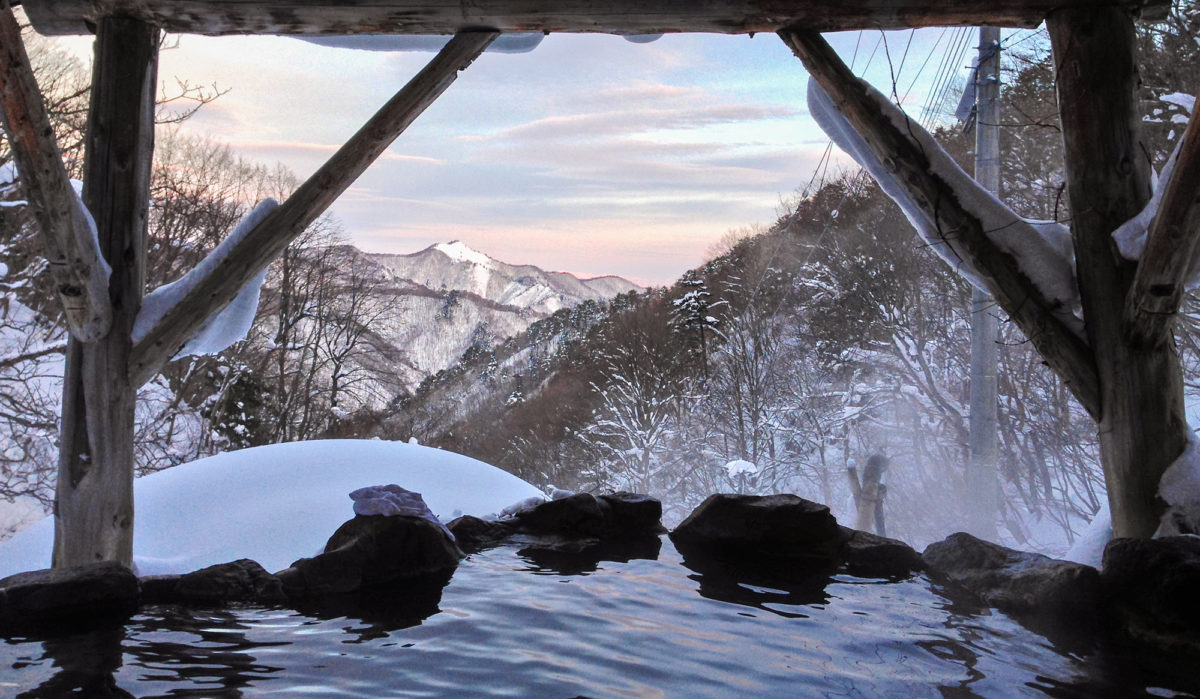There are few wintertime pleasures greater than a soak in an onsen after a day on the slopes. It’s a combination I’ve grown so accustomed to from living in Japan that now no snowboarding trip feels complete without one.
Soaking in onsen (natural hot springs) is not only a pleasure, but also effective for recovery. Traditional Japanese folk medicine, as well as modern conventional medicine, acknowledges the healing properties of onsen water. Bathing in onsen doesn’t just feel good, it helps muscles and joints recover from physical exertion, helps injuries recover faster and may prevent old ones from flaring back up. The upshot is that evenings spent relaxing in hot springs may actually help skiers and snowboarders improve their performance.
The ultimate indulgence is to stay overnight at an onsen inn near a ski area, where you can come “home” to a hot bath followed by a multi-course kaiseki meal or hearty lodge fare. In the morning, wake up to another fine meal and warm bath before heading back out into the elements for another day on the slopes.
Skiers and snowboarders traveling on a budget can enjoy the pleasure of an apres-ski soak too—many onsen inns open their baths to non-staying guests for a nominal fee during the afternoon and early evening. Miyagi also boasts an abundance of day-trip hot springs facilities dotted throughout the prefecture, including near ski areas.
Sumikawa Snow Park & Gaga Onsen
Personally, my favorite ski x onsen combination in Miyagi is Sumikawa Snow Park and Gaga Onsen. Gaga Onsen is a lone hot spring inn tucked away in a gorge on Mount Zao. In spite of the secluded location, a free shuttle bus service connects the onsen and snow park. Sumikawa Snow Park is moderately-sized resort that, in addition to the pistes, also makes a great base for backcountry skiing/snowboarding on Mount Zao. After the thrill and exertion of a day spent exploring the backcountry, it feels hugely comforting to return to the warmth and tranquility of Gaga Onsen.
Onikobe Ski Resort & Onikobe Pension Village
The most convenient ski x onsen combination can be found at Onikobe Ski Resort. The ski resort’s on-site hotel, Hotel Onikobe (ホテルオニコウベ), boasts onsen baths, as do most of the lodges in the Pension Village (ペンション村) area located a just few minutes’ walk from the resort. The Pension Village area offers natural hot springs, hearty fare, and cozy accommodation at moderate prices. Day-trippers are welcome to use the baths at Hotel Onikobe anytime between 10 a.m. and 4 p.m.
Eboshi Ski Resort & Togatta Onsen
Eboshi Resort and Togatta Onsen (遠刈田温泉) make a great combination for those who want a bit of nightlife to accompany their stay. There is a wide range of accommodations in Togatta Onsen, from the preeminent luxury of Chikusenso to more moderately priced establishments like Hoshiakari no Yado Mahoroba. Togatta Onsen isn’t exactly a party destination, but does have enough izakaya, karaoke bars, etc. to make for a decent pub crawl. Day-trip hot springs facilities in Togatta Onsen, like Mahoroba no Yu are open late—even day trippers staying to night ski can stop in for a soak afterwards. On weekends and holidays, a free shuttle bus runs between Togatta Onsen and Eboshi Resort.
Shiroishi Ski Resort & Kamasaki Onsen
Shiroishi Ski Resort and Kamasaki Onsen (鎌先温泉) is a combination especially well-suited to hot spring aficionados. Kamasaki Onsen is a quiet hot spring village consisting of five inns, including Yunushi Ichijo. It boasts six hundred years of history, remarkable Taisho-era architecture, and waters praised by samurai for their efficacy. Though there’s no public transportation between Kamasaki Onsen and Shiroishi Ski Resort, they are located just ten kilometers apart. Those willing to drive or call for a taxi can enjoy the hot springs village and skiing/boarding at their leisure.
